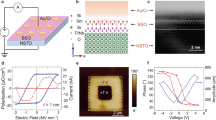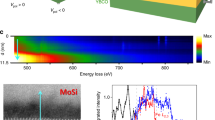Abstract
Ferroic-order parameters1 are useful as state variables in non-volatile information storage media because they show a hysteretic dependence on their electric or magnetic field. Coupling ferroics with quantum-mechanical tunnelling allows a simple and fast readout of the stored information through the influence of ferroic orders on the tunnel current. For example, data in magnetic random-access memories2 are stored in the relative alignment of two ferromagnetic electrodes separated by a non-magnetic tunnel barrier, and data readout is accomplished by a tunnel current measurement. However, such devices based on tunnel magnetoresistance3 typically exhibit OFF/ON ratios of less than 4, and require high powers for write operations (>1 × 106 A cm−2). Here, we report non-volatile memories with OFF/ON ratios as high as 100 and write powers as low as ∼1 × 104 A cm−2 at room temperature by storing data in the electric polarization direction of a ferroelectric tunnel barrier. The junctions show large, stable, reproducible and reliable tunnel electroresistance, with resistance switching occurring at the coercive voltage of ferroelectric switching. These ferroelectric devices emerge as an alternative to other resistive memories4, and have the advantage of not being based on voltage-induced migration of matter at the nanoscale5,6, but on a purely electronic mechanism7.
This is a preview of subscription content, access via your institution
Access options
Subscribe to this journal
Receive 12 print issues and online access
$259.00 per year
only $21.58 per issue
Buy this article
- Purchase on Springer Link
- Instant access to full article PDF
Prices may be subject to local taxes which are calculated during checkout




Similar content being viewed by others
References
Schmid, H. Some symmetry aspects of ferroics and single phase multiferroics. J. Phys. Condens. Matter 20, 434201 (2008).
Ikeda, S. et al. Magnetic tunnel junctions for spintronic memories and beyond. IEEE Trans. Electron. Dev. 54, 991–1002 (2007).
Moodera, J. S., Kinder, L. R., Wong, T. M. & Meservey, R. Large magnetoresistance at room temperature in ferromagnetic thin film tunnel junctions. Phys. Rev. Lett. 74, 3273–3276 (1995).
Waser, R. & Aono, M. Nanoionics-based resistive switching memories. Nature Mater. 6, 833–840 (2007).
Yang, J. J. et al. Memristive switching mechanisms for metal/oxide/metal nanodevices. Nature Nanotech. 3, 429–433 (2008).
Jo, S. H., Kim, K-H. & Lu, W. High-density crossbar arrays based on a Si memristive system. Nano Lett. 9, 870–874 (2009).
Dawber, M., Rabe, K. M. & Scott, J. F. Physics of thin-film ferroelectric oxides. Rev. Mod. Phys. 77, 1083–1130 (2005).
Velev, J. P. et al. Magnetic tunnel junctions with ferroelectric barriers: predictions of four resistance states from first principles. Nano Lett. 9, 427–432 (2009).
Tsymbal, E. Y. & Kohlstedt, H. Tunneling across a ferroelectric. Science 313, 181–183 (2006).
Zhuravlev, M. Y., Sabirianov, R. F., Jaswal, S. S. & Tsymbal, E. Y. Giant electroresistance in ferroelectric tunnel junctions. Phys. Rev. Lett. 94, 246802 (2005).
Kohlstedt, H., Pertsev, N. A., Rodriguez Contreras, J. & Waser, R. Theoretical current–voltage characteristics of ferroelectric tunnel junctions. Phys. Rev. B 72, 125341 (2005).
Esaki, L., Laibowitz, R. B. & Stiles, P. J. Polar switch. IBM Tech. Discl. Bull. 13, 2161 (1971).
Tybell, T., Ahn, C. H. & Triscone, J-M. Ferroelectricity in thin perovskite films. Appl. Phys. Lett. 75, 856–858 (1999).
Junquera, J. & Ghosez, P. Critical thickness for ferroelectricity in perovskite ultrathin films. Nature 422, 506–509 (2003).
Fong, D. D. et al. Ferroelectricity in ultrathin perovskite films. Science 304, 1650–1653 (2004).
Kim, Y. S. et al. Critical thickness of ultrathin ferroelectric BaTiO3 films. Appl. Phys. Lett. 86, 102907 (2005).
Rodriguez-Contreras, J. et al. Resistive switching in metal–ferroelectric–metal junctions. Appl. Phys. Lett. 83, 4595–4597 (2003).
Kohlstedt, H. et al. Method to distinguish ferroelectric from nonferroelectric origin in case of resistive switching in ferroelectric capacitors. Appl. Phys. Lett. 92, 062907 (2008).
Garcia, V. et al. Giant tunnel electroresistance for non-destructive readout of ferroelectric states. Nature 460, 81–84 (2009).
Maksymovych, P. et al. Polarisation control of electron tunneling into ferroelectric surfaces. Science 324, 1421–1425 (2009).
Gruverman, A. et al. Tunneling electroresistance effect in ferroelectric tunnel junctions at the nanoscale. Nano Lett. 9, 3539–3543 (2009).
Choi, K. J. et al. Enhancement of ferroelectricity in strained BaTiO3 thin films. Science 306, 1005–1009 (2004).
Kalinin, S. V. et al. The role of electrochemical phenomena in scanning probe microscopy of ferroelectric thin films. ACS Nano 26, 5683–5691 (2001).
Wang, R. V. et al. Reversible chemical switching of a ferroelectric film. Phys. Rev. Lett. 102, 047601 (2009).
Bristowe, N. C. et al. Electrochemical ferroelectric switching. Preprint at http://arXiv.org/1108.2208 (2011).
Garcia, V. et al. Ferroelectric control of spin polarisation. Science 327, 1106–1110 (2010).
Brinkman, W. F., Dynes, R. C. & Rowell, J. M. Tunneling conductance of asymmetrical barriers. J. Appl. Phys. 41, 1915–1921 (1970).
International Technology Roadmap for Semiconductors, 2009; available at http://www.itrs.net/links/2009itrs/home2009.htm.
Stengel, M., Vanderbilt, D. & Spaldin, N. A. Enhancement of ferroelectricity at metal–oxide interfaces. Nature Mater. 8, 392–397 (2009).
Highland, M. J. et al. Polarisation switching without domain formation at the intrinsic coercive field in ultrathin ferroelectric PbTiO3 . Phys. Rev. Lett. 105, 167601 (2010).
Rodriguez, B. J., Callahan, C., Kalinin, S. V. & Proksch, R. Dual-frequency resonance-tracking atomic force microscopy. Nanotechnology 18, 475504 (2007).
Acknowledgements
The authors thank H. Jaffrès, P. Seneor and P. Metaxas for fruitful discussions as well as S. Vinzelberg, R. Goschke and B. Holmes at Atomic Force for technical assistance with the PFM measurements. Financial support from the European Research Council (ERC advanced grant no. 267579), French C-Nano Île de France and the French Réseau Thématique de Recherche Avancée Triangle de la Physique is acknowledged. X.M. acknowledges support from the Herchel Smith Fellowship.
Author information
Authors and Affiliations
Contributions
V.G., K.B., M.B. and A.B. conceived and designed the experiments. X.M., N.D.M., A.Cr., J.A., S.X., B.D. and C.D. were responsible for the preparation and nanofabrication of the samples. A.Ch., V.G., K.B., S.F., A.M. and R.P. performed the PFM measurements. A.Ch., A.Cr., V.G., J.G., K.B. and S.F. performed the electrical measurements. A.Ch., A.Cr., V.G., S.F., K.B., M.B. and A.B. analyzed the data. V.G. and M.B. co-wrote the paper. All authors contributed to the manuscript and the interpretation of the data.
Corresponding author
Ethics declarations
Competing interests
The authors declare no competing financial interests.
Supplementary information
Supplementary information
Supplementary information (PDF 565 kb)
Rights and permissions
About this article
Cite this article
Chanthbouala, A., Crassous, A., Garcia, V. et al. Solid-state memories based on ferroelectric tunnel junctions. Nature Nanotech 7, 101–104 (2012). https://doi.org/10.1038/nnano.2011.213
Received:
Accepted:
Published:
Issue Date:
DOI: https://doi.org/10.1038/nnano.2011.213
This article is cited by
-
A ferroelectric fin diode for robust non-volatile memory
Nature Communications (2024)
-
Performance improvement of a tunnel junction memristor with amorphous insulator film
Discover Nano (2023)
-
Direct observation of intrinsic room-temperature ferroelectricity in 2D layered CuCrP2S6
Nature Communications (2023)
-
Greatly enhanced tunneling electroresistance in ferroelectric tunnel junctions with a double barrier design
npj Computational Materials (2023)
-
Anomalous ferroelectric retention at cryogenic temperature
Science China Materials (2023)



